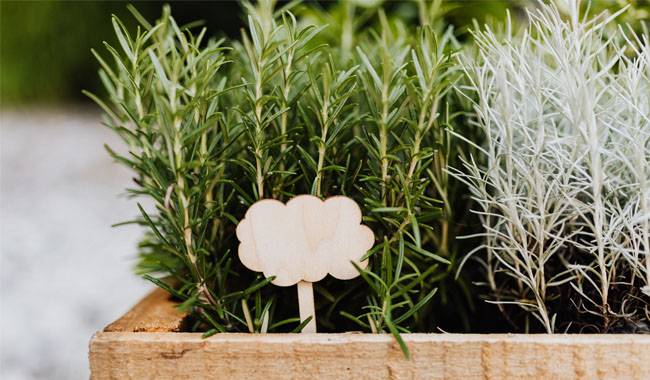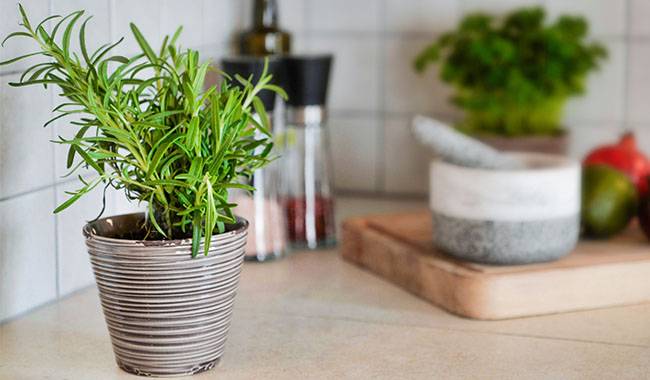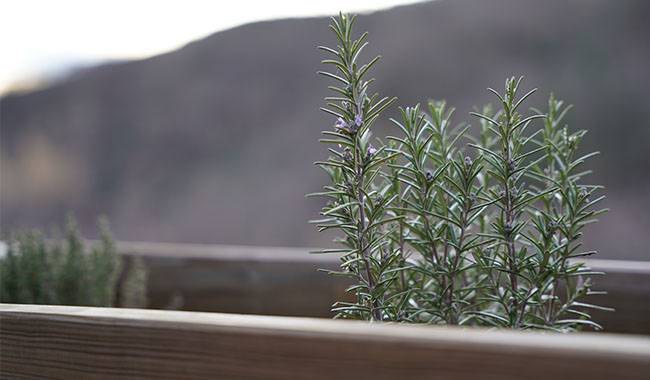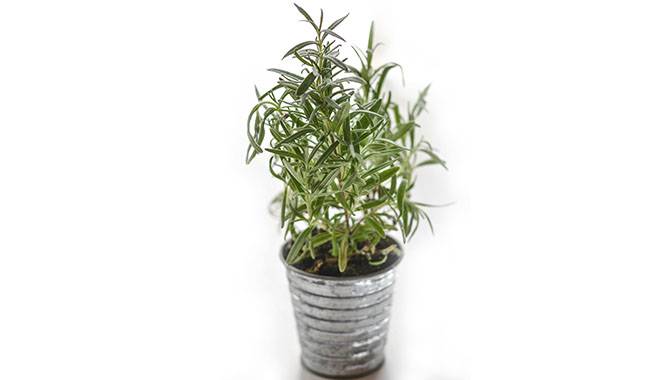
I don’t familiar with rosemary very well before. I lacked experience and knowledge for how to propagate rosemary from cuttings wilted due to non-compliance with the rules of planting and care. For a while, I even refused to grow this useful plant.
One day, I was thinking of to challenge for growing rosemary at home. But why? Because the essential oil, which is part of the plant tissue, has a beneficial effect on the nervous system and suggests improving sleep patterns.
I decided to prepare thoroughly and collect all the necessary information. I cuttings some rosemary from friends who have been growing it for a long time.
WHAT IS ROSEMARY
This plant is known as a medicinal plant. Many people use it as a spice, as a plant that contains essential oils and purifies the air.
Because rosemary is very versatile and demanding, it can only be grown on Garden plots in southern regions, where it is hot.
In temperate regions, it is recommended to grow rosemary indoors. At the same time, you should avoid the main mistakes that many amateur flower growers make.
ROSEMARY ORIGIN
Naturally, rosemary can be found in the Mediterranean, North Africa, and Southern Europe. These regions are considered to be the birthplace of the plant.
Around the world, rosemary does not grow in natural conditions, it has been present in botanical gardens since 1813. As a cultivated plant, it can only be grown in suitable climates.
Rosemary has been widely known since ancient times. It was used by the ancient Romans, Egyptians, and Greeks as a medicinal plant and a primitive spice.
To this day, the amazing “herringbone” has been in demand and popular. Many people grow the lovely shrub as an ornamental plant with interesting needles and blue flowers.
ROSEMARY FORMS
Rosemary or common rosemary is a subshrub or shrub. They attribute him to the lambda family and the genus Rosemary.
The height of the bush can vary from half a meter to several meters. The branches have a pubescent surface and their structure is four-sided.
The leaves are linear, evergreen, located on very small buds. The upper part of the leaves is slightly rounded and dense and maybe slightly curled.
Flowering is expressed by almost sessile flowers, which form 5-10 pseudo-racemes. They are formed at the top of the branches. The outside of the corolla is pubescent, bluish-blue, with a purple tinge.
At the end of the flowering period, the fruit is formed – oval, with rounded edges, smooth surface, brownish, in the shape of a nut.
The flowering period begins in the second half of April and lasts until the middle of May. In hot countries, rosemary can bloom until November.
TECHNIQUES FOR GROWING ROSEMARY PLUGS
The main thing is to properly prepare to grow this herb, then maintain and care for the plant. After many years, it will please with fragrant and tender branches.
Selecting plugs
- You can go to a nursery or nursery where buds of about 10-12 cm (3.93-4.72inch) in length are made, preferably at the beginning of spring to make blanks. Harvest in autumn only in warm climate areas.
- Some people order cuttings online. Rosemary comes in many varieties with white-green foliage and can even be found with blue tones. The bushes can be lush, but there are also some bushes consisting of small buds and short shoots.
- If you plan to grow rosemary in the south, it can be planted all year round, except in winter. In mild climates, from the third decade of April to the beginning of March, you will need to prepare the grass cuttings for sowing. In this case, in late spring and early summer, you can plant grass in the open spaces on the site.
Important note: the plugs are taken only from the upper part of the buds, these are taken from the upper part of the buds of adult rosemary bushes.
PREPARING THE CUTTINGS
The most common mistake growers make is that the cuttings cannot be stored long enough to form rhizomes. Planting directly into the ground will result in the death of the buds. They do not take root.
- Prepare a container beforehand, you can use a container or a pot. Prepare the land as well. Most often, buy ready-made formula. But you can prepare the soil yourself.
- Take the following ingredients: hummus, black soil, river sand, and peat. Mix until smooth.
- It is necessary to remove the bottom leaves of rosemary and plant the cuttings in the prepared holes. Deepen the sprouts by 3-4cm (1.18-1.57inch).
- After sowing the seeds, the soil must be well moistened and then watered. Next, place the pot or container on a windowsill and wait for rooting in 4 to 6 weeks.
- It is very important to observe the watering rules. It is necessary to moisten the soil moderately, but usually at least 3-4 times a week. At the same time, do not pour in the soil and excess water should be drained from the tray immediately.
- After the specified time, the cuttings must be removed and transplanted into bare soil. It is important that the soil is warm. If you do not have a garden, you can plant rosemary on a balcony or cool porch. Plants actively recognize the day and night temperatures, they alternate.
There is another way to wait for the appearance of roots in the plugs. To constantly control the formation of roots, you can place the buds in a cup.
It must be changed at least once every 3 days. It is important to have enough light and warmth in the room for the sprouts.
Since rosemary is a capricious and demanding plant, you should carefully consider the composition of the soil.
It is highly recommended not to grow rosemary in dense, high soil, high clay, and high alkaline soil. Make sure to loosen the soil so that water does not remain in the roots.
It is important to maintain a balance and conserve water. Too much water can lead to crumb rot. Too much dry air and lack of moisture are also harmful to the plant.
WHEN TO PLANT
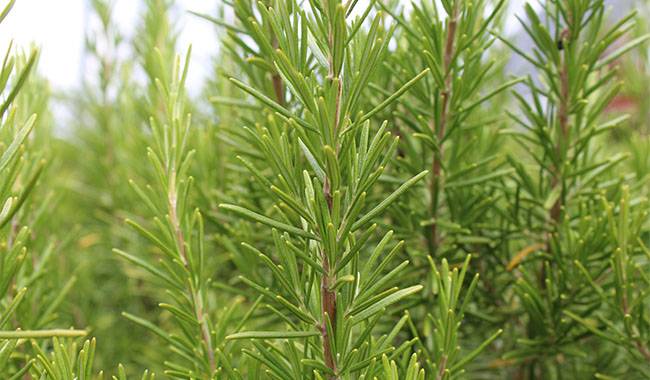
Rosemary can be planted at different times depending on climatic conditions. In the middle lane, the best temperature for sowing is between 5-10°C (41-50°F).
In the northern parts of the open zone, it is not advisable to plant this plant, because low temperatures and low falls will not allow the root system or branches to develop well. Grow only in greenhouses and hotbeds.
In central areas, plant rosemary bushes from the second half of April. If the temperature drops below -5, rosemary will die.
Therefore, in autumn and winter, the plant should be dug up and moved to a warmer place. In this way, the plant can grow for many years.
In the room where rosemary grows, the temperature should be around 5-15°C (41-59°F) and then the bush will grow and grow well.
LOCATION
This plant is very heat-loving and sensitive. Therefore, it is not suitable for northern or places with draughts or wind. Humid areas with standing water are also not suitable.
The most comfortable would be the east or south side of the plot, or a room that is not drafty, warm, and well-lit. Rosemary is negative to sudden changes in temperature.
It is also good if next to the place where it is planted, there will be a wall of structures or dense shrubs that will protect rosemary.
For the plant, the soil should be light, loose, airy, and well-drained. The root system needs enough oxygen.
And the soil should be well permeable to moisture. If the soil is very acidic, use lime. Spread a small amount of dolomite powder and lime.
Place a drainage layer at the bottom of each planting hole. You can buy clay minerals or other similar “loosening agents” at the store. You can use pebbles, gravel, or broken bricks.
PLANTING
- Prepare the seedlings well in advance with a minimum distance of 1 meter (3.2 feet) between them.
- Prepare a special nutrient-rich soil mixture for planting. Take the ratio of leaf soil, peat, and river sand. Mix together, adding 1 tablespoon of finely crushed chalk for every 1 kg of such soil.
- Bury the cuttings in the soil up to the bottom leaves. Next, you need to water the plants and cover them with polyethylene or film. 7 days should pass before removing the cover. During this time, the cuttings should take root and sprout.
Often a plant that has been growing for many years will have bare stems. Experienced growers are advised to remove all side shoots. This should be done no more than once every 7 years.
The first harvest is usually obtained 3 years after planting. Branches are cut off along with the bluebonnets. The twigs are cut off when the rosemary is in flower.
The shrub grows rather slowly and should reach a maximum height of about 90cm (35.4inch) in a pot. Repot each time in a larger pot.
HOW TO GROW ROSEMARY – METHOD
Rosemary is a perennial plant in the Juniperaceae family, densely covered with dark green needle-shaped leaves and delicate lilac flowers.
Rosmarinus means “freshness of the sea” in Latin. Rosemary has a pungent flavor with a hint of pine needles and is a spice used in cooking, and its essential oil extracted from the leaves is used in medicine, cosmetology, and aromatherapy.
Rosemary is native to the Mediterranean, but that doesn’t stop gardeners from growing rosemary in their yards for ornamental purposes.
HOW TO GROW ROSEMARY FROM CUTTINGS AT HOME?
Accustomed to growing in a humid and warm environment, the shrub is difficult to root in temperate climates, so planting and further growing rosemary from cuttings is the best option. Planted this way, it will grow faster and stronger.
HOW TO CUT ROSEMARY
Rosemary cuttings are stem tops cut from adult rosemary that are about 10cm (3.93inch) long and consist of 3-4 internodes. Growing rosemary cuttings at home take some time to form a root system.
Cuttings are planted in pots with a moist soil mixture of caraway, peat, mulch, and sand to a depth of 4cm (1.57inch) and are well watered.
The lower leaves are mandatory to be cut off. The container with the seedlings is placed inside the house on a warm windowsill on the sunny side. Periodically place the seedlings with the other side facing the sun.
Please note Water rosemary every other day to ensure it does not linger. 4-6 weeks later, it can be planted outdoors.
Rosemary prefers a light, sandy soil that is regularly loosened and weeded to prevent waterlogging. On acidic, alkaline, and oily soils, the shrubs do not develop well and will eventually die.
In southern regions, rosemary cuttings can be taken almost all year round, except in winter. In the middle belt areas, rosemary tops are cut at the end of September for root formation and potting in winter, and hardened seedlings are planted outdoors near summer.
HOW TO GROW ROSEMARY FROM TWIGS?
This planting method can be used in any warm season. Cut young shoots of 5-6cm (1.96-2.36inch) from an adult shrub and place them in a glass dish with water in a warm and bright place.
We recommend changing the water at least once every three days. Once rosemary has rooted, it can be transferred to a lighter soil, nutrient-rich pot.
GROWING FROM SEED
Rosemary is usually grown from seeds as seedlings for open-field planting or for home floriculture. Seeds are purchased in specialized stores, both foreign and domestically produced.
Foreign seeds do not require pre-treatment before sowing, as they have already been treated with stimulants. Pre-germination with wet gauze is recommended in China.
Germination of seeds takes place within a month, so the preparation starts closer to spring, around the end of February – the beginning of March.
It is recommended to sterilize the containers and soil for planting to avoid fungal or bacterial diseases of the seeds.
In warm sunlight, place the seeds, which have dried out and become too watery, at a distance of 2cm (0.78inch), sprinkle them lightly with water, cover them with a thin layer of soil (5mm), and sprinkle them again.
Close the container to create a greenhouse effect and move it to a warm place, out of the sun.
Important note: The film has holes for air circulation.
The soil surface is regularly sprinkled with water to prevent drying. After the first sprouts appear, remove the film and transfer the container to a warm place with plenty of light. When 3-4 true leaves appear, transplant the seedlings into separate containers, which, as well as the soil in them, are treated with a disinfectant solution.
HOW TO GROW ROSEMARY FROM SHOOTS?
Mature shrubs are easy to grow from shoots in spring. Under 2-3 strong shoots, open a trench to a depth of 5 cm (1.96inch). The shoots are bent to the ground, fixed with nails, covered with soil, and watered intensively.
It is recommended to feed them with mineral fertilizer several times a month so that they can take root by autumn. After that, the branches are separated from the main clump and replanted. For areas with frost, plant the branches first in pots and transplant them to the open ground in spring.
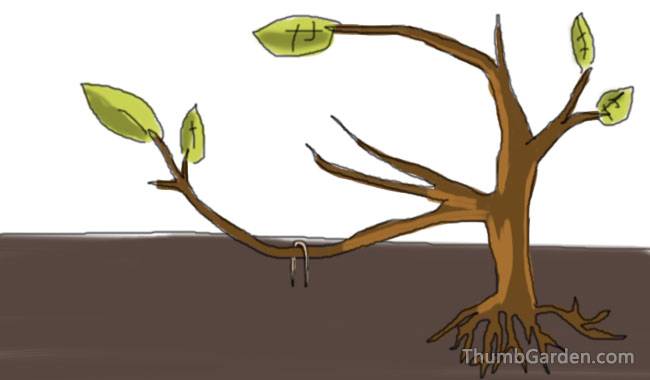
CARE OF SEEDLINGS
A few weeks before planting in the open field, the seedlings harden. To do this, first, open the windows and ventilate the room where the boxes are located. Then the pots with seedlings are brought outside in the shade or on the open porch for about 3-4 hours a day.
Rosemary is less tolerant of frost, so seedlings are planted after the soil has warmed to 5-10°C (41-50°F). Choose a planting site on a sunny side, sheltered from wind and rain, with light, loose sandy soil.
Please note Lack of sunlight will result in stunted bush development, inability to flower and set seeds for planting, and reduced essential oil production from the leaves.
Although drought-tolerant, rosemary prefers moisture, although excessive moisture is not good for it. To avoid waterlogging, drainage material such as coarse pebbles or swelling soil is poured into the hole before planting.
A mixture of 2 parts of leaf soil, 2 parts of coarse sand, 1 part of peat, and 1 tablespoon of crushed chalk per 1 kg of soil mixture was laid on top of the drainage layer. The holes prepared in this way were left for 72 hours to allow the soil to sink naturally, and then the seedlings were planted.
HOW TO GERMINATE ROSEMARY
If the rosemary serves only an ornamental purpose, the distance between the seedlings is 10-15 cm (3.93-5.9inch). Future seedlings of the medicinal shrub will be harvested and planted at least half a meter (1.64foot) apart from each other.
It is recommended to water rosemary moderately: every other day on hot days and once a week in cool weather. Water with warm water in the evening to avoid dripping water touching the leaves.
Loosening the soil and weeding must be done about once a month. Covering with a crust of soil keeps warm air from getting to the roots and weeds from stirring up standing water.
Important! Too much moisture in the soil under rosemary shrubs can lead to root rot and the appearance of fungi and bacteria. Staying in dry soil for long periods of time slows growth, the plant fails to flower, and the leaves wilt and turn yellow.
Rosemary grows in the house and in regular feeding is not particularly necessary. It is enough to fertilize the shrub once a month with a mixture of minerals and organic matter. Calculate the dosage strictly according to the instructions.
Starting from the second year, thin the crown of the shrub and cut off diseased and harmful shoots. To make the canopy more fluffy, pull off the top.
Every six years, all shoots are cut off to rejuvenate the plant. This is best done in warm weather around the beginning of April.
Tip of the hat! In winter, dig rosemary out of the open ground, transplant it into pots, and plant it at home. In southern regions, it is sufficient to cover the roots of the shrub with sawdust, straw, or agricultural ambrosia.
The article provides information on how to root rosemary and grow it from seeds, cuttings, or grafting. It is 100% helpful in deciding on the choice of method, and this fragrant crop will decorate the garden for more than a year.
HOW TO GROW ROSEMARY?
Rosemary is an evergreen shrub that grows in Africa, Turkey, and other southern regions. The plant is ornamental and can be used for medicine and cooking.
Growing rosemary from seeds is one of the ways to grow this shrub. New plants can also be obtained from cuttings, branches, divided shrubs, and grafting.
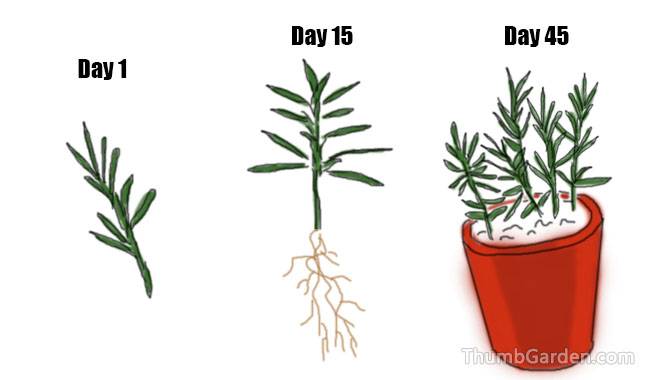
There are several methods of growing rosemary.
Cutting
Cut the stems from the top of adult shrubs. They are then rooted in a special substrate. Cuttings provide some conditions that promote root formation. The prepared seedlings are planted on the plot.
By seed
In this planting method, it is important to prepare the planting material and soil. To improve the germination rate of seeds, they are processed. The seedlings receive constant care and a special microclimate is created indoors. Once the shrubs are grown, they are planted outdoors.
Twigs
The cut branches are kept in warm water. When roots appear, they are planted in pots or outdoors.
By dividing the bush
The planting method is used when transplanting rosemary. Its rhizome is divided into several parts and planted where it is needed.
HOW TO PROPAGATE ROSEMARY FROM CUTTINGS
A cutting is the top part of a bush shoot. It is cut from adult plants, bought at the market or in the store. The cuttings are propagated with a length of 8 to 10 cm (3.14-3.93inch) and 3 to 4 internodes.
Procedure for planting rosemary cuttings.
- For planting, prepare the container and soil. The substrate is purchased at the store or obtained by mixing pruning soil, humus, peat, and sand.
- Pour clay stones or broken bricks in the bottom of the container and fill them with soil.
- Make pits in the soil and plant the cuttings at a depth of 3cm (1.18inch). Cut off all the leaves from the bottom of the cuttings.
- Water the soil well. Place the container in a warm, bright place.
- When propagating the shrubs, water the cuttings 4 times a week.
- After a month and a half, the seedlings can be placed in a fixed position.
In the south, rosemary cuttings can be taken at any time of the year, except in winter. In the middle zone, cuttings are prepared in September and October. They are rooted in winter and planted outdoors in summer.
HOW TO PROPAGATE ROSEMARY FROM SEEDS
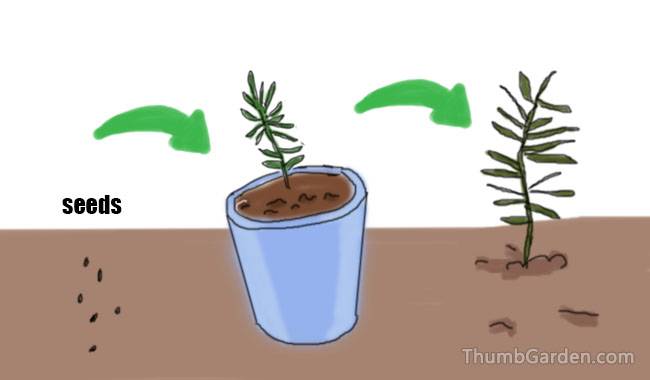
Rosemary seeds should be sown in late February or March. Propagation is carried out using the seedling method. Plant them at home, then transfer the seedlings to the ground.
Before propagating rosemary, prepare containers and substrates. For planting, choose a pot no more than 15cm (5.9inch) in height. Place a layer of expanded clay or other drainage material in the bottom. Inevitably provide holes in the container.
Soil for rosemary is prepared independently or buy a ready-made mixture. The best solution – mix garden soil with river sand and compost in the ratio of 2:1:1. Any soil with neutral acidity and suitable for indoor plants is fine.
Rosemary’s seeds are very small and take a long time to germinate. Treat them to improve germination rates. The seeds are first kept in water. When the seeds have swollen, they are ready to be planted.
The order of propagating plants from seeds.
- A container with drainage and soil is well watered.
- The seeds are distributed on the soil. Pour a layer of soil no more than 0.5 mm on top.
- Water the plants with warm water using a sprayer.
- Cover the container with polyethylene and place it in a warm place.
Sprouting occurs at a temperature of 25°C (77°F). Turn the film over periodically to remove condensation. To prevent the soil from drying out, wet the soil with a sprayer every 2 to 3 days.
The first sprouts will appear after one month. Then remove the film and move the container to a bright place. On average, wait for 6 to 8 weeks for seed propagation of rosemary.
It is not enough to grow rosemary with seeds, but also to take good care of the seedlings. Place the container on a windowsill. Keep the room temperature at 18°C (64.4°F).
When the rosemary seedlings have 2 to 3 leaves, they can be harvested into their own containers. The soil used is the same as the soil used for sowing. When transplanting, try not to damage the root system.
When the seedling will reach 3-4cm (1.18-1.57inch) high, start hardening it. First, open the windows to ventilate the room.
Then move the container with seedlings to the balcony or terrace. Before planting in the ground, the plants must be fully adapted to natural conditions.
Plant shrubs in a permanent place with a height of 7-8 cm (2.75-3.14inch). Choose a sunny place for them, sheltered from cold winds.
The best soil for rosemary is light, fertile, and well-drained. transplant seedlings in May or June, when the weather is warm after the frost.
HOW DO I GROW ROSEMARY FROM TWIGS?
A large clump of rosemary can be successfully grown from a single branch. Young shoots 5cm (1.96inch) long are best.
They should be cut from a mature bush. This propagation method can be used at any time of the year. Sprouts are rooted at home.
Procedure for propagating shrubs from twigs.
- Place the cut shoots in a jar filled with water. A rootstock stimulant can be added to the solution.
- Change the water every 3 days.
- When the shoots have roots, put them into a container with light nutrient soil.
- Water rosemary moderately and keep it in a warm and bright place.
After the seedlings grow, they can be planted in the ground or left in pots. Rootstock rosemary branches can be in a greenhouse, which provides a suitable microclimate.
Propagate rosemary by dividing the shrub.
If rosemary is already growing on the plot, propagate it by dividing the rhizomes. This method is used when repotting.
Every year, shrubs that are more than 5 years old need to be replanted. By replanting, you will not only rejuvenate the plant but also get new seedlings.
If rosemary is growing in the wrong place – not enough water and sunlight – it also needs to be replanted. This procedure is recommended if the shrub is located in a low-lying area or suffers from water damage.
This work should be done in spring or in autumn when the sap movement slows down. As a result, the shrub is more resistant to planting and roots faster in new places.
Instructions for propagating rosemary by division.
- Dig the shrub out of the ground or remove it from the pot.
- Remove the roots from the soil and divide them into several parts. Use pre-sterilized pruning shears or other tools.
- Each seedling should have a number of roots and shoots. If there are old, diseased, or dry branches, they should be removed.
- The cut is treated with charcoal.
- The roots of the seedlings are immersed in water with a growth promoter.
- All that is left is to plant the rosemary in a container or in a bed.
HOW TO PROPAGATE ROSEMARY WITH APRONS?
Rosemary is easily propagated by transplanting. You do this in the spring. To do this, choose 2 or 3 of the strongest shoots. Dig a 5cm (1.96inch) deep slot under them. Branches are put down, secured with metal spikes, and covered with soil. A part of the branch should remain above the ground surface. The shoots are then watered well.
The mineral complex is used for rearing. Infusion of cowpeas and other natural means are used at the beginning of the season. Excessive organic matter inhibits the development of rosemary. Fertilizer is applied 2-3 times a month.
By autumn, the branches are well-rooted. They are separated from the mother bush and planted in place. In cold climates, it is better to transplant the shed branches into pots for the winter and transplant them to the street in the spring.
WHICH METHOD IS BETTER
The choice of the method of propagation of rosemary depends primarily on the initial data. The choice of working time takes into account the weather conditions in the region.
If the shrub has not yet been planted, it is better to buy seeds or cuttings. If you already have plants, you can choose to propagate rosemary from cuttings, or grafting.
The most common method of propagation is cuttings. When transplanting, it is recommended to divide the shrub to reduce trauma to the plant.
These are reliable methods that retain all the characteristics of the species. Propagation with the help of transplants is more suitable for growing shrubs in the garden. In the country, you should prefer other methods of propagation.
Propagation by seeds is the most time-consuming method. To get healthy seedlings, you must use a good substrate, take care of the seedlings and create a microclimate for them. If seeds are used, the plant may lose its species traits.
CONCLUSION
Growing rosemary from seeds is not an easy process and requires careful preparation. First, prepare the container, soil, and planting materials.
In order to get sprouts, you need to create a certain microclimate at home. Rosemary can also be propagated by cuttings and propagation.




